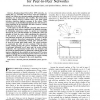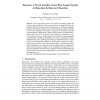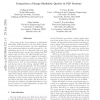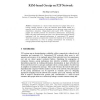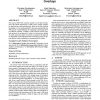116
Voted
TPDS
2008
15 years 6 days ago
2008
Abstract-- Broadcast-based Peer-to-Peer (P2P) networks, including flat (e.g., Gnutella) and two-layer super-peer implementations (e.g., Kazaa), are extremely popular nowadays due t...
112
click to vote
ISI
2008
Springer
15 years 10 days ago
2008
Springer
In this paper, we propose managing data summaries in unstructured P2P systems. Our summaries are intelligible views with two main virtues. First, they can be directly queried and u...
119
click to vote
AINA
2004
IEEE
15 years 4 months ago
2004
IEEE
Peer-to-peer (P2P) computing offers many attractive features, such as self-organization, load-balancing, availability, fault tolerance, and anonymity. However, it also faces some ...
MIDDLEWARE
2004
Springer
15 years 5 months ago
2004
Springer
Peer-to-peer (P2P) systems are becoming increasingly popular and complex, serving millions of users today. However, the design of current unstructured P2P systems does not take ful...
99
Voted
ACNS
2006
Springer
15 years 6 months ago
2006
Springer
Unstructured P2P systems have gained great popularity in recent years and are currently used by millions of users. One fundamental property of these systems is the lack of structu...
129
click to vote
P2P
2006
IEEE
15 years 6 months ago
2006
IEEE
Given some of the recent advances in Distributed Hash Table (DHT) based Peer-To-Peer (P2P) systems we ask the following questions: Are there applications where unstructured querie...
INFOCOM
2006
IEEE
15 years 6 months ago
2006
IEEE
— While structured P2P systems (such as DHTs) are often regarded as an improvement over unstructured P2P systems (such as super-peer networks) in terms of routing efficiency, it...
104
click to vote
ICA3PP
2007
Springer
15 years 6 months ago
2007
Springer
Classification is a kind of basic semantics that people often use to manage versatile contents in daily life. Resource Space Model (RSM) is a semantic model for sharing and managin...
110
Voted
ICPP
2007
IEEE
15 years 6 months ago
2007
IEEE
— Most of existing search algorithms for unstructured peer-to-peer (P2P) systems share one common approach: the requesting node sends out a query and the query message is repeate...
103
click to vote
WWW
2006
ACM
16 years 1 months ago
2006
ACM
Peer-to-peer (P2P) Web search has gained a lot of interest lately, due to the salient characteristics of P2P systems, namely scalability, fault-tolerance and load-balancing. Howev...
